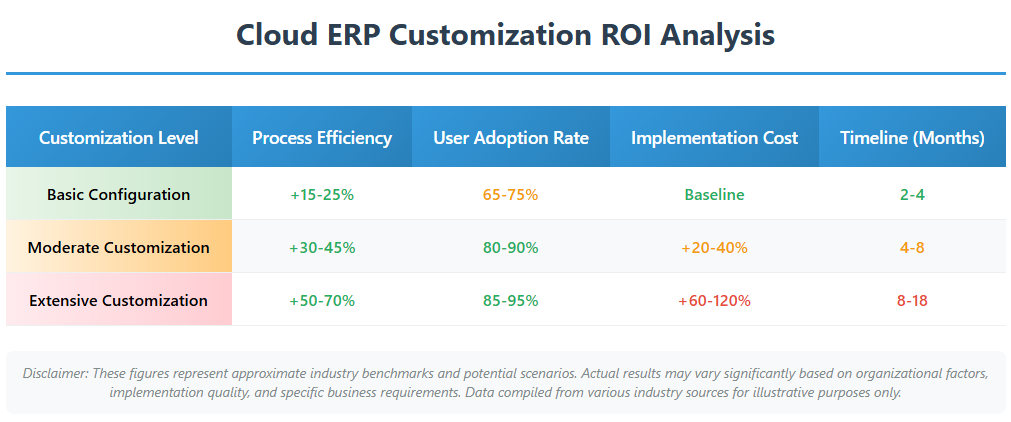Sage Hosting System Requirements: Complete Checklist
September 11, 2025Master QuickBooks mobile hosting for anywhere access. Professional cloud solutions transform your accounting workflow with enterprise security and flexibility.

Business leaders face increasing pressure to streamline operations while maintaining a competitive edge. The shift toward cloud-based solutions has opened up new opportunities for companies seeking flexible and scalable enterprise systems. With gotomyerp cloud ERP platforms, organizations often strike an effective balance between standardized functionality and tailored business processes.
The landscape of ERP customization continues evolving. What once required extensive coding and lengthy implementation cycles has, in many cases, become more accessible through modern configuration tools and API-driven architectures. Understanding these options helps business leaders make informed decisions about their technology investments.
Most ERP professionals recognize a fundamental distinction between configuration and customization approaches. Configuration typically involves using built-in system tools to modify workflows, reports, and user interfaces without altering core application code. This path generally offers greater flexibility while preserving system integrity during future updates.
Customization, by contrast, may involve developing new functionality or modifying existing code structures. While this approach offers unlimited possibilities, it often necessitates more careful planning and ongoing maintenance considerations.
Workflow Configuration Tools Modern cloud platforms frequently include sophisticated workflow engines that enable business process mapping without extensive programming. These tools enable organizations to define approval hierarchies, automate routine tasks, and establish custom business rules that align with their specific operational requirements.
Dashboard and Interface Personalization User interface customization capabilities allow teams to create role-specific views of business data. This might include custom reporting dashboards, personalized key performance indicators, and department-specific interfaces designed to enhance productivity.
Third-party integration capabilities often facilitate seamless connections with existing software investments through API-driven architectures. Organizations can frequently maintain their current technology stack while leveraging new cloud ERP functionality through strategic integrations.
According to Gartner’s 2024 market analysis, the ERP software market grew 11.3% to $66 billion, with cloud ERP adoption being a key driver of growth. This trend suggests increasing business confidence in cloud-based customization approaches.
Note: The following data represents industry approximations and potential scenarios. Actual results may vary significantly based on organizational factors, implementation approach, and specific business requirements.

Begin with Comprehensive Process Analysis Successful customization projects typically start with thorough documentation of existing business processes. Organizations often benefit from identifying which procedures truly require modification versus those that can be effectively implemented with standard functionality.
Focus on Core Business Differentiators Many experts recommend prioritizing customization efforts on processes that directly impact competitive positioning or regulatory compliance. Secondary functions achieve better results through configuration approaches or process adaptation.
Design for Future Scalability McKinsey research on ERP transformations emphasizes the importance of designing systems that can adapt to changing business requirements. Planning for growth and evolution helps ensure long-term value from customization investments.
Maintain Comprehensive Documentation Detailed documentation of customizations—including business rationale, technical specifications, and testing procedures—helps preserve institutional knowledge and facilitates future maintenance activities.
Different sectors often require unique customization strategies. Manufacturing companies might prioritize production planning and quality control modifications, while service organizations frequently focus on project management and billing workflow enhancements.
Organizations seeking robust infrastructure to support diverse customization requirements may find Enterprise Hosting solutions beneficial for maintaining optimal performance and security standards.
Healthcare Industry Considerations Healthcare organizations often face extensive regulatory requirements that may necessitate significant modifications to their systems. These customizations usually need to balance functional requirements with stringent security and privacy compliance standards.
Manufacturing Sector Needs Manufacturing companies frequently require integrations with production equipment, complex inventory management capabilities, and quality assurance processes. Such modifications often demand real-time data processing and reporting functionality.
Cloud ERP Customization Project Phases
Phase 1: Discovery & Planning (2-4 weeks)
Current State Assessment → Requirements Documentation → Resource Planning → Risk Evaluation
Phase 2: Design & Development (4-12 weeks)
Technical Architecture → Custom Development Work → Integration Configuration →Interface Development
Phase 3: Testing & Deployment (2-6 weeks)
System Integration Testing → User Acceptance Validation → Performance Tuning → Production Rollout
Phase 4: Optimization & Support (Ongoing)
User Training Programs → Performance Monitoring → Continuous Improvement → System Maintenance
Disclaimer: Timeline estimates are approximate and may vary considerably based on project complexity, organizational preparedness, and available resources. Consult with implementation professionals for more precise planning and guidance.
Version Control Systems Implementing robust version control helps ensure that customizations can be tracked, modified, and potentially reversed when necessary. This approach may help minimize risks associated with system updates and changes.
Dedicated Testing Environments Separate testing environments enable organizations to validate customizations before production deployment, potentially reducing the likelihood of operational disruptions.
Change Management Processes Established protocols for evaluating, approving, and documenting customization modifications help ensure that changes align with business objectives and technical standards.
Cloud ERP customizations should typically be designed with system performance in mind. This often includes optimizing database interactions, minimizing resource consumption, and ensuring that custom functionality doesn’t negatively impact overall system responsiveness.
Database Optimization Strategies Custom reports and workflows generally benefit from careful database design that minimizes processing load. This might involve strategic indexing, data archiving procedures, and efficient query structures.
User Interface Performance Custom dashboards and interfaces typically require optimization for responsive user interactions, which is particularly significant for mobile and remote access scenarios.
Customizations should generally maintain the security standards of the base ERP system. This often includes appropriate access controls, data encryption protocols, audit trail capabilities, and regulatory compliance features.
According to McKinsey’s research on ERP platform approaches, organizations can reduce costs and improve outcomes by planning strategic customization.
Data Protection Measures Custom functionality should typically incorporate appropriate data protection protocols, including encryption standards, access logging, and data retention policies that align with organizational and regulatory requirements.
Audit Trail Maintenance Customizations generally should maintain comprehensive audit capabilities that track user activities, data modifications, and system changes for compliance and security monitoring purposes.
Q: How long might cloud ERP customization typically take? A: Implementation timelines vary considerably based on complexity, but many projects range from 8 to 24 weeks. Simple configuration changes can be completed in a matter of days, while extensive customizations require several months of development and validation work.
Q: Can customizations affect system update capabilities? A: Modern cloud ERP platforms are generally designed to maintain customizations through updates, though some modifications may require testing and potential adjustments. Working with experienced providers can help ensure smoother transitions during upgrade cycles.
Q: What distinguishes customization from configuration approaches? A: Configuration typically uses built-in system tools to modify behavior without changing core code, while customization often involves developing new functionality or modifying existing code structures. Configuration is generally faster, less expensive, and easier to maintain over time.
Q: Can ERP systems be customized after initial implementation? A: Yes, cloud ERP systems are typically designed to accommodate ongoing customization as business needs evolve. However, post-implementation changes may require additional planning to minimize disruption to existing operations.
Q: How should organizations determine which processes need customization? A: Many experts recommend focusing on processes that provide a competitive advantage, have strict regulatory requirements, or cannot be efficiently managed through standard functionality. Consider the cost-benefit ratio and long-term maintenance requirements for each potential customization.
Q: What happens if customizations don’t work as expected? A: Reputable ERP providers typically offer testing environments and rollback capabilities to address customization issues. Proper planning, testing, and documentation may minimize risks and ensure quicker resolution when problems arise.
Q: Are there limitations to what can be customized in cloud ERP systems? A: While cloud ERP platforms often offer extensive customization capabilities, some core system functions may have limitations to ensure security and performance. Working with experienced providers helps identify optimal approaches for specific requirements.
Cloud ERP customization presents a significant opportunity for organizations seeking to optimize their operations while leveraging the benefits of cloud-based infrastructure. Success typically depends on careful planning, effective resource allocation, and adherence to established industry standards and best practices.
The key to effective customization often lies in balancing business requirements with technical feasibility, while also considering future scalability and maintenance needs. Organizations that approach customization strategically may achieve substantial improvements in operational efficiency, user satisfaction, and competitive positioning.
Discover the possibilities with our comprehensive platform and expert guidance. Test drive our demo today—it’s completely free—to see how customized cloud ERP solutions might address your specific business challenges and potentially unlock new growth opportunities.